Research Highlights
Here, we present some highlights of our department’s research soon after they are published. An effort is made to write about the specific research in an easy-to-understand language to make it accessible to those who are not specialists on that particular topic. Specialists and those want to know more can click on the link to the publication to gain an in-depth knowledge about that work.
Low-cost method for the detection of adulterants in milk
Susmita Dash & Virkeshwar Kumar
Milk is a multi-component system that contains non-volatile milk solids (fats, protein, salt) and volatile (water-enriched material, ketones, alcohols, hydrocarbons, and esters) medium. For monetary gains and maintaining the gap between demand and supply, vendors often perpetrate the unethical practice of adulterating milk. Adulteration of milk poses a severe health hazard, and it is crucial to develop adulterant-detection techniques that are scalable and easy to use.
We propose a simple evaporative deposition-based technique to detect the presence of two of the most common adulterants – water and urea in milk. In pure milk, we observe a specific pattern formation of the non-volatile milk solid deposited at the end of evaporation. These patterns change or diminish with the addition of water. In the case of diluted milk-urea, the crystallization pattern of urea in the droplet is used as a tool to detect the addition of urea in milk. The detection of urea can be improved by the dilution of milk. Based on the detection level of urea, we present a regime map that shows the concentration of urea that can be detected at different extents of dilution of milk. Using the proposed evaporative deposition-based technique, added water in excess of 20% and added urea as low as 0.4% can be detected.
While milk is a complex system and adulteration may not be restricted to only water or urea, this evaporation-based method opens up an avenue to explore the dependence of evaporative deposition pattern on the composition of milk and use it as a physical detection tool for detecting adulterants at home or any remote location.
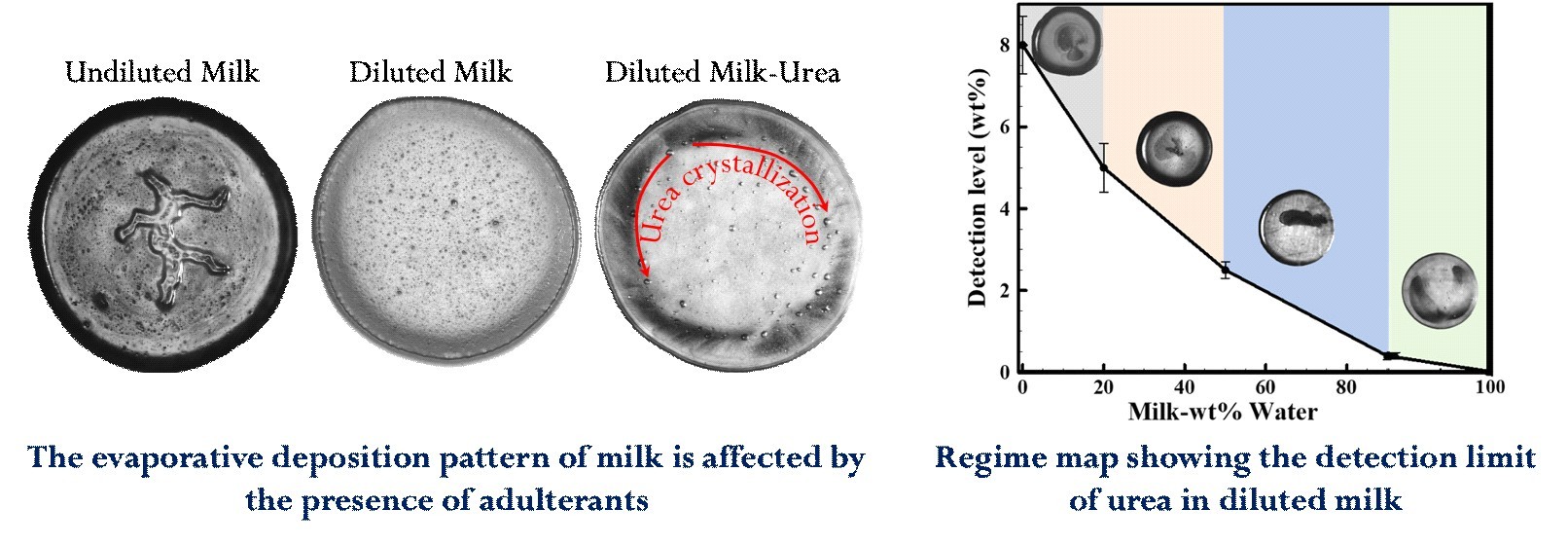
Reference:
[1] Virkeshwar Kumar, and Susmita Dash, “Evaporation-Based Low-Cost Method for the Detection of Adulterant in Milk,” ACS Omega, 6(41), 2021, pp. 27200–27207.
The link to the paper is: doi.org/10.1021/acsomega.1c03887
Posted on October 30, 2021
Symmetric-breaking bifurcations in two-dimensional square vortex flows
Weakly driven fluid flows are often spatially symmetric due to geometry of physical boundaries and/or spatial modulation of body forces. For instance, laminar flow in a straight pipe with circular (or square) cross section is symmetric with respect to continuous (discrete four-fold) azimuthal rotations. When driven strongly, however, real-world flows always become spatially asymmetric and, eventually, spatiotemporally chaotic. Interestingly, the onset of spatial asymmetry can be either gradual (supercritical) or sudden (subcritical), depending on whether and how a symmetric flow becomes unstable to infinitesimal asymmetric perturbations.
In this study, we numerically explored symmetry breaking bifurcations in two-dimensional square vortex flows, which are preferred test beds for exploring geophysical hydrodynamics in a laboratory setting. When driven weakly, the flow is composed of a chessboard like arrangement of square vortices. However, with increasing driving (Reynolds number), the flow undergoes a sequence of supercritical/subcritical bifurcations leading to the formation of different types of spatially asymmetric flows (e.g., steady, time-periodic, pre-periodic, and quasi-periodic).
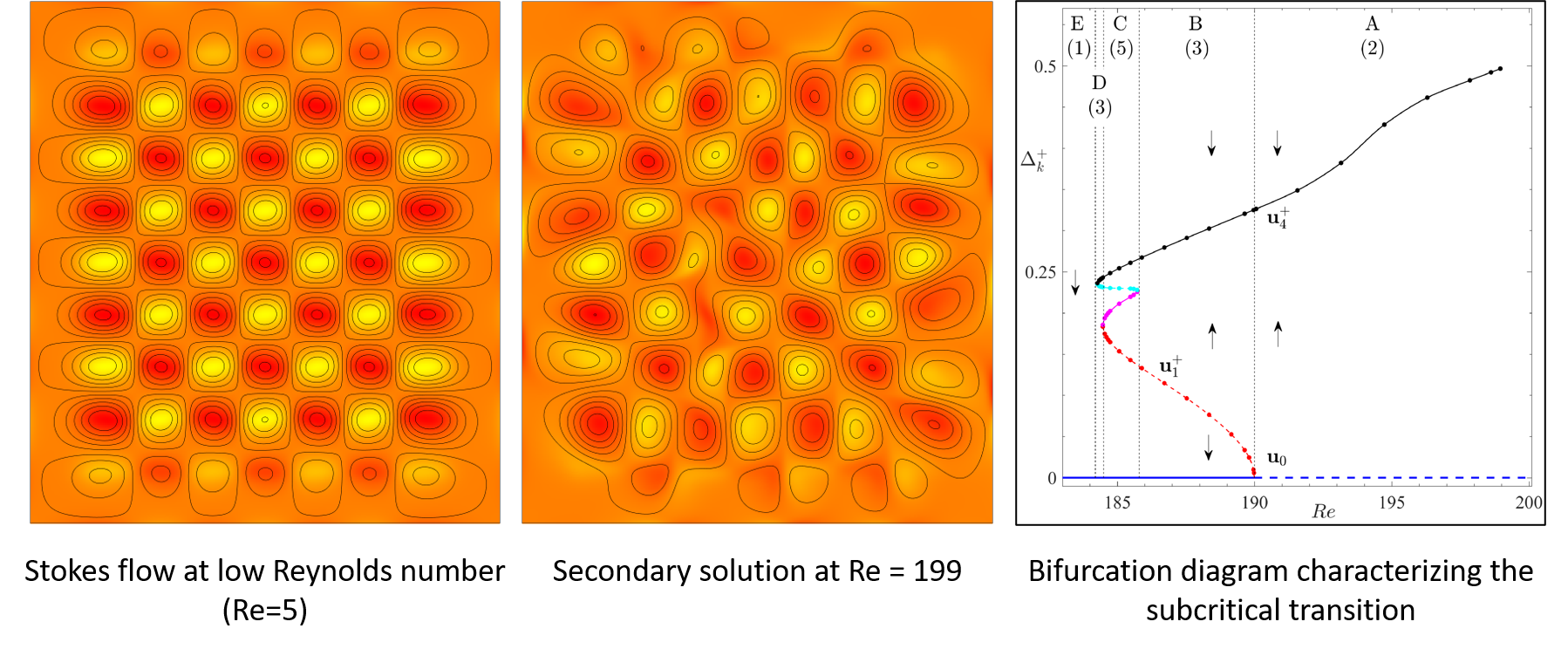
Posted on October 1, 2021
Identifying new materials with novel thermal properties (Navaneetha K. Ravichandran and David Broido)
Navaneetha K. Ravichandran and David Broido
In crystalline electrical insulators, heat is carried by phonons, which are quantized vibrations of the crystal lattice. As these phonons travel through the material, they collide with each other, thereby limiting the material’s thermal conductivity (k). Predicting how frequent and strong these collisions are (“collision rates”) for each material under different experimental conditions is computationally expensive. This can slow down the discovery of new materials, with their k values and trends tailored to our needs.
New research led by Navaneetha Krishnan Ravichandran at the Department of Mechanical Engineering now provides a way to identify materials that show intriguing temperature- and pressure-dependencies of k, without performing these full, expensive computations.
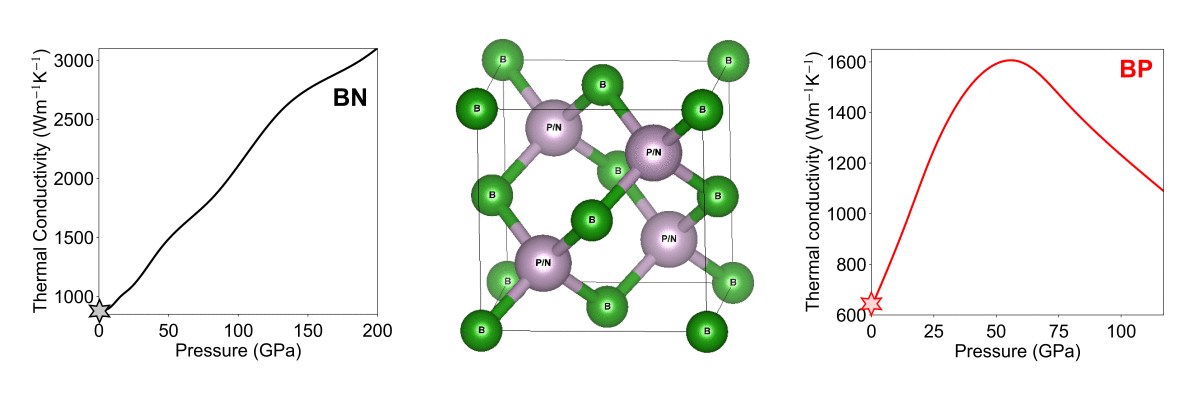
In an earlier publication [1], Ravichandran and collaborator David Broido at Boston College, USA developed a set of guidelines to identify materials with unusually weak rates of three-phonon collisions, directly from the phonon dispersion relations, which describes the temporal frequencies and energy content in different collective vibration modes propagating through the crystal lattice of each material. These dispersion relations and the guidelines arising out of them, are significantly less expensive to compute than the full three-phonon collision rates. The guidelines were derived from certain “selection rules” arising from the energy and momentum conservation restrictions on phonon collisions in quantum mechanics, which eventually control the relative strength of different three-phonon collision events.
In a new study [2], the researchers used these insights to predict an unusual pressure-dependence of the k of a material called boron phosphide (BP). They found that BP has a unique phonon dispersion relation: when pressure is applied, the resulting changes in the phonon dispersion relations cause a very strong interplay between different three-phonon collision processes, driven primarily by the aforementioned selection rules.
At the material level, this interplay results in an unusually sharp rise in its k with pressure, which the researchers predict to be the steepest in any material. It also results in a peak and subsequent drop in the k of BP with pressure, in stark contrast to the linearly increasing trend seen in most other materials. The current study is an exciting application of the selection rule framework to identify new materials with novel thermal transport phenomena.
References
[1] Navaneetha K. Ravichandran & David Broido, Physical Review X 10, 021063, 2020
[2] Navaneetha K. Ravichandran & David Broido, Nature Communications 12, 3473, 2021
Posted on July 8, 2021
On the dynamics of vortex–droplet co-axial interaction: insights into droplet and vortex dynamics (Saptarshi Basu and team)
Shubham Sharma, Awanish Pratap Singh and Saptarshi Basu
Interaction of droplets with vortical structures is ubiquitous in nature, ranging from raindrops to a gas turbine combustor. We elucidate the mechanism of co-axial interaction of a droplet with a vortex ring of different circulation strengths (Γ = 45–161 cm2 s−1). We focus on both the droplet and the vortex dynamics, which evolve in a spatio-temporal fashion during different stages of the interaction, as in a two-way coupled system. In the interaction dynamics, different regimes are identified, including deformation (regime-I), stretching and engulfment (regime-II) and breakup of the droplet (regime-III). Each interaction regime is explained using theoretical models that closely match the experimental data.
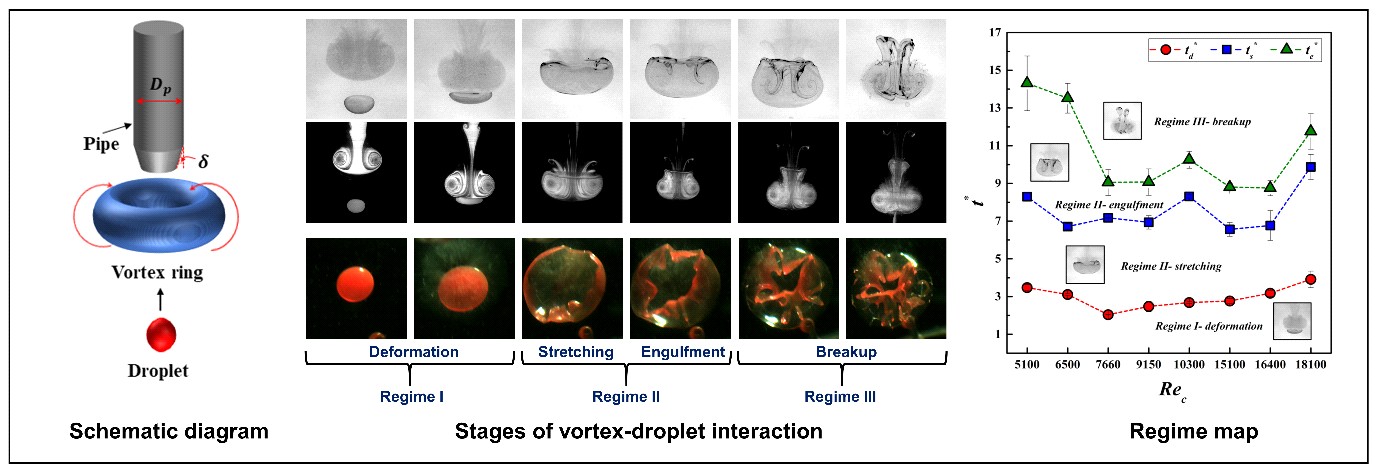
Figure 1. Vortex-droplet interaction mechanism (adapted from Sharma et al. 2021 JFM [1]).
Regime-I corresponds to droplet deformation, in which flow around the droplet surface was induced due to the incoming vortex ring. This causes the generation of high-pressure regions near the forward (north pole) and backward (south pole) stagnation points of the droplet. These high-pressure regions exert a compressive force on the droplet surface that exceeds the surface tension force and causes droplet deformation. Regime-I ends for different experimental cases at t∗ = 2–4. Regime-II corresponds to the stretching and engulfment of the droplet. When a vortex ring comes in contact with the flattened droplet, it exerts a shear force, which causes stretching of the droplet and its subsequent wrapping around the vortex ring. The stretching of the droplet (regime-II) exists up to t∗ = 6–10 for all experimental cases. A decrease in pressure from the outer far-field area to the vortex ring centre was shown by processing the PIV velocity field. This differential pressure exerts a net inward force on the leading edge of the droplet and results in its engulfment. The droplet engulfment for different experimental cases ends at t∗ = 9–15. The last regime in the droplet dynamics is the breakup of the droplet (regime-III). Three modes of droplet breakup were identified in this regime, including breakup of the engulfed ligament, detachment of stretched bag from the upper rim and the rupture of the stretched bag.
In the vortex dynamics, we have investigated the effect of interaction on vorticity distribution, circulation strength, pressure distribution, total energy and enstrophy and the translational speed of the vortex ring. The circulation strength was decreased for all experiments due to vortex ring interaction. The reduction in circulation was higher at lower vortex ring strengths (case-I and case-II), where a maximum decrement of ∼30 % was found. Normalised pressure difference contours for the interacting vortex ring had lower absolute values compared with its reference case (without interaction). It was found that the total energy and enstrophy of the vortex ring drastically decreased during the period from stretching to the breakup of the droplet. In the cases I–IV of this study, significant decrements of ∼50 % and ∼40 % were observed in total energy and enstrophy of the vortex ring, respectively.
Finally, this work encompassed a wide range of vortex rings (laminar to turbulent) and the studied interaction phenomenon is complex and involved different spatial–temporal scales. An extension to the present work can be carried out to provide universal insights into the interaction phenomenon.
Reference:
[1] S. Sharma, A.P. Singh, S. Basu, On the dynamics of vortex–droplet co-axial interaction: insights into droplet and vortex dynamics, J. Fluid Mech. 918 (2021) 1–36. https://doi.org/10.1017/jfm.2021.363.
Posted on May 31, 2021
Generation of stable, well-controlled and nearly periodic 3D cone cracks in hydrogels (M. S. Bobji and team)
Needle insertion, a standard process for various minimally invasive surgeries, results in tissue damage which sometimes leads to catastrophic outcomes. Opaqueness and inhomogeneity of the tissues make it difficult to observe the underlying damage mechanisms. For the first time, we have found of periodic, stable and well-controlled 3-D cone cracks inside the tissue-mimicking hydrogel during deep penetration. We show that the stress field around the needle tip is responsible for the cone cracks symmetry and periodicity. These results provide a better understanding of the fracture processes in soft and brittle materials such as lung, liver and brain tissues during needle insertion based surgical operations. The results presented in this work can also aid in optimising needle design such that the tissue damages could be minimised in various needle insertion involved medical intervention procedures.

The video of this work on the publisher’s page: http://www.rsc.org/suppdata/d0/sm/d0sm02145h/d0sm02145h1.avi
Posted on February 2, 2021
Simultaneous Imaging of Multiple Species in Flames using FRAME (Ravikrishna and team)
During the combustion of hydrocarbon fuels, multiple intermediate products are formed such as hydroxyl (OH), formaldehyde (CH2O), Polycyclic Aromatic Hydrocarbons (PAHs), CH, CO, etc., which depend on the stoichiometry of the flame. Intermediate products such as OH, CH2O, CH and CO control the heat release rate of a flame. Furthermore, soot is produced under fuel-rich conditions, depending on the concentration of PAH. Therefore, the “footprint” of these chemical species can be used to track the combustion and post-combustion processes. Due to the stricter emission norms, much attention has been given to further understanding of the combustion chemistry and especially, the soot formation.
Quantitative measurements in flames are challenging, as simultaneous multi-species measurements are required. A variety of optical measurement techniques are used to measure single and multi-species in flames, e.g. light scattering, absorption and fluorescence spectroscopy. The most common ones are Laser-induced fluorescence (LIF) and Laser-induced incandescence (LII).
For simultaneously imaging of multiple species in flames, a combination of multiple lasers and several cameras (which are time-gated and/or equipped with different spectral filters) are required – making the optical setup complex and resource-intensive. Furthermore, despite their ability of mapping multiple species in a plane, all the “conventional” measurements are often perturbed by issues such as stray light and background radiation.
 a) Single-shot FRAME (Frequency Recognition Algorithm for Multiple Exposures) image of the flame along with cross-patterned unprocessed sub-image and its FFT consisting of modulated signals of OH-LIF and soot-LII. (b) Processed OH-LIF image (c) soot-LII image of the flame – extracted by applying the FRAME algorithm to (a).
a) Single-shot FRAME (Frequency Recognition Algorithm for Multiple Exposures) image of the flame along with cross-patterned unprocessed sub-image and its FFT consisting of modulated signals of OH-LIF and soot-LII. (b) Processed OH-LIF image (c) soot-LII image of the flame – extracted by applying the FRAME algorithm to (a).
A collaborative effort by Prof. Ravikrishna’s group and researchers from Friedrich‐Alexander University, Germany, reported simultaneous qualitative imaging of two species in a flame on a single camera without the use of an image doubler or additional cameras. The planar multispecies imaging technique FRAME based on structured illumination imaging was used where the intensity of the laser sheet is spatially modulated.
The link to the paper: https://www.mdpi.com/1424-8220/20/19/5534/pdf
Citation: Sensors 2020, 20, 5534; doi:10.3390/s20195534
Posted on October 10, 2020
Bubble-induced rupture of droplets on tailored surfaces (Susmita Dash and Team)
Bursting of bubbles is ubiquitous with numerous applications ranging from spraying of pesticides, drug delivery, and inkjet printing to forming emulsions. Understanding the parameters that influence the dynamics of bubble rupture is crucial to design systems with improved performance. Here, we experimentally investigate the main morphological parameters of a droplet deforming on a lubricant-impregnated surface (LIS) and hydrophobic surfaces due to continuous air inlet. We show that the extent of bubble growth upon air injection into a sessile droplet is dependent on contact angle hysteresis and viscosity of oil in the case of LIS. The location of the nucleation of hole resulting in bubble-induced rupture is explained in terms of the preferential thinning of the water and water−oil bilayer thin film near the contact line or the apex of the droplet.
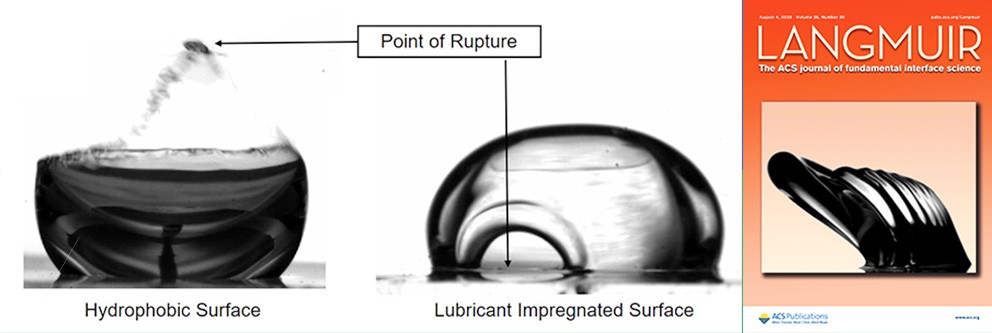
The link to the paper is: https://doi.org/10.1021/acs.langmuir.0c01187
Citation: Langmuir 2020, 36, 30, 8858–8864
Posted on September 25, 2020
Mechanics of Elastic Ribbons (Ramsharan Rangarajan and Team)
Ribbons are slender structures characterized by three disparate geometric dimensions— length 𝓁, width 𝑤 and thickness h. The pair of large aspect ratios 𝓁∕𝑤 and 𝑤∕h dictate their rich buckling-dominated mechanical behavior. In many ways, a growing field of research on the mechanics of ribbons is exemplary of an evolving paradigm in engineering that considers buckling and related geometric nonlinearities as features to be exploited, rather than as modes of failure. Understanding the feature-rich behavior of thin elastic ribbons is in fact ripe with opportunities for fundamental studies exploring the nexus between geometry and mechanics, and for conceiving of engineering applications that exploit geometric nonlinearity as a functioning principle.
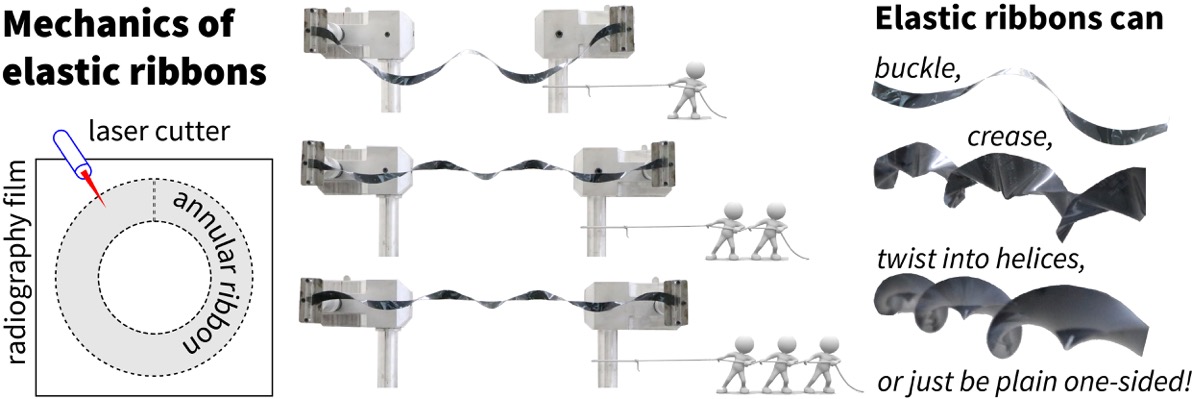
In a recent study, the research group of Dr Ramsharan Rangarajan critically examine modeling approaches for elastic ribbons using detailed measurements of complex three-dimensional deformations realized in experiments. Rather surprisingly, they find that simple and practically realizable ribbon deformations contradict assumptions underlying the most commonly used models. They go on to identify and validate a geometrically nonlinear theory over a useful range of loading conditions.
Through the study, the researchers demonstrate annular ribbons to be prototypical systems for studying the mechanics of elastic ribbons. Their experiments reveal that annular ribbons exhibit a tunable degree of nonlinearity, possess multiple stable equilibria, show bifurcation phenomena correlated with the number of zero crossings in the mean curvature, and provide evidence for the localization of energy, thus making annular ribbons interesting mechanical systems to study in their own right.
Reference:
Posted on August 31, 2020
